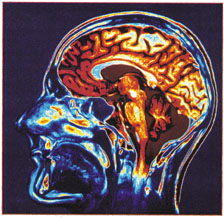
1975 - 1985: Images
by Hans Christian von Baeyer, College of William and Mary
 Peering into the human body with a Magnetic Resonance Imaging (MRI). (Photo from the A Century of Physics Time Line Wall Chart.) |
On July 20, 1976, a couple of weeks after the two hundredth birthday of the United States, an automated spacecraft landed on Mars and beamed back images of its red soil. The world held its breath as a robot searched for extraterrestrial life (and found none). As significant as the experiment, was the manner in which the news was reported to the public. As a result of the universal spread of color TV, visual images began to supplant the written and spoken word which had been the principal carrier of news since antiquity.
Science itself has long recognized the value of human vision enhanced by technology. To the telescopes, microscopes, and cameras of classical physics the twentieth century has added television, holography, and, most importantly, the computer. The field of computer graphics, which builds upon discoveries in modern physics, has in turn become an indispensable tool for basic research.
In 1981 an ancient dream came true when the outlines of individual atoms were revealed to the human eye for the first time. The instrument that made this possible, called the Scanning Tunneling Microscope (STM), consists of a fine needle whose tip gently scans a surface the way a blind person's fingertip might scan an unfamiliar face. The digitized contours are fed into a computer which organizes them into a picture resembling the underside of an egg carton: each bump represents a single atom. Synthetic color coding adds to the contrast and helps to identify atoms of different species. The resulting map of the invisible atomic landscape we inhabit is imbued with a haunting beauty.
In medicine the combination of computers with different probes has yielded equally dramatic results. Views of the brain produced by pencil-thin beams of X-rays - useless when considered individually - are assembled by Computerized Tomography (CT) scanners into three-dimensional color coded images that have revolutionized neurosurgery. Ultrasound images of fetuses have benefited obstetrics. Other techniques for peering into the human body include Magnetic Resonance Imaging (MRI), which produced the picture and Positron Emission Tomography (PET scanning), which records the radiation emitted when positrons from radioactive materials administered to the body annihilate electrons in nearby cells.
Even pure mathematics, the queen of the sciences aloof from the material world, has embraced computer graphics. The Mandelbrot set, for example, a mathematical structure whose delicate beauty and complexity fascinates mathematicians, artists, and computer whizzes, owed its discovery in 1979 to the emerging image making capability of the computer.
The generations of physicists after 1975 will not look at the world through glass lenses, but at its image on a computer monitor. What will they see?
Editor's Note: A CENTURY OF PHYSICS, a dramatic illustrated timeline wallchart of over a hundred entries on eleven large posters is intended for high schools and colleges. Each poster covers about a decade and is introduced by a thumbnail essay to provide a glimpse of the historical and scientific context of the time. A Century of Physics will be on display at the Atlanta Centennial Meeting in March.
In the January 1999 issue, APS News will feature the tenth and penultimate introductory essay: 1985 - 1995: Taking a Second Look.
©1995 - 2024, AMERICAN PHYSICAL SOCIETY
APS encourages the redistribution of the materials included in this newspaper provided that attribution to the source is noted and the materials are not truncated or changed.
December 1998 (Volume 7, Number 11)
Articles in this Issue

